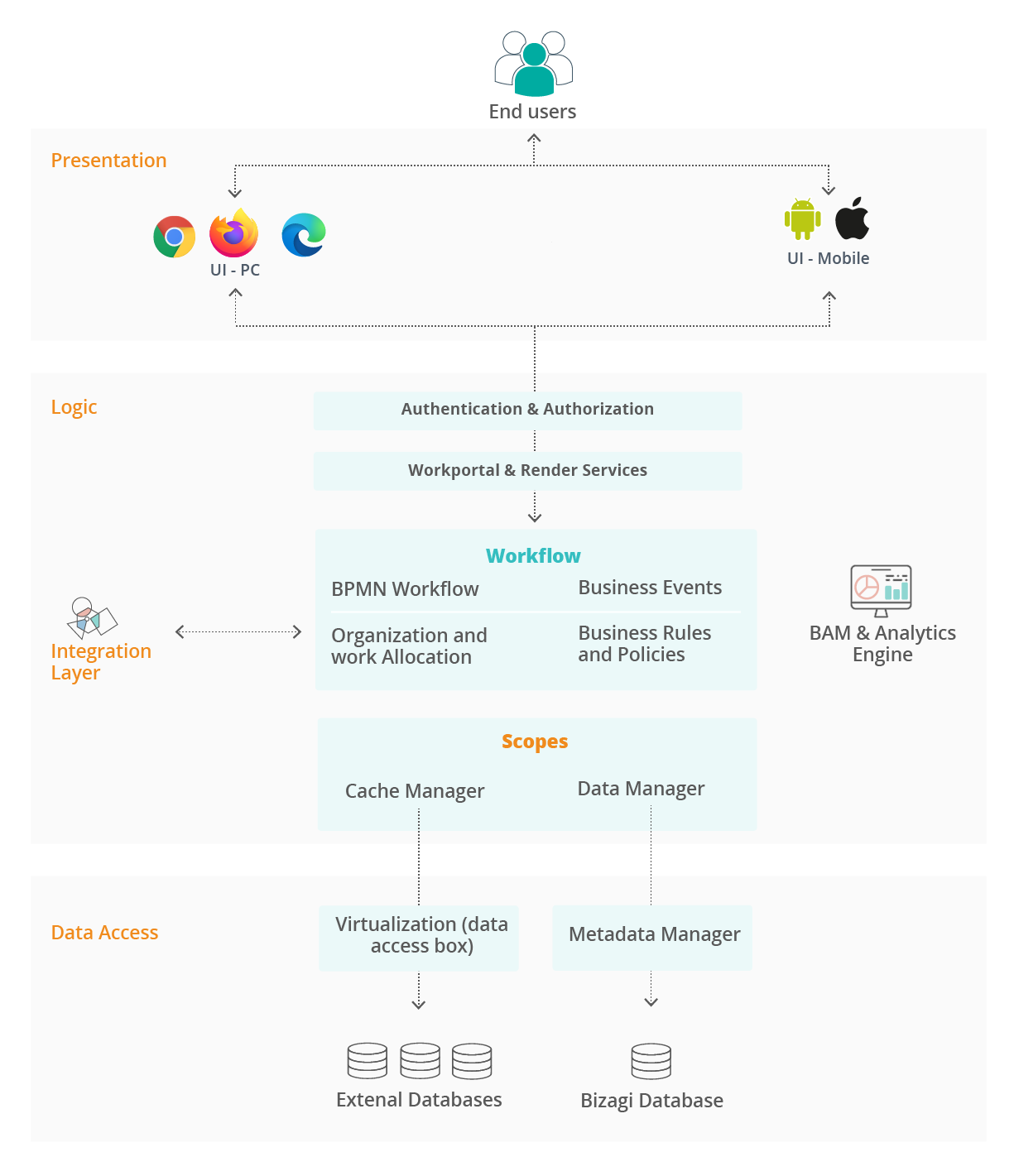Work Portal architecture
Bizagi's internal architecture is designed with modern technologies to provide a complete enterprise-class solution. Its model-driven approach eliminates the need for intermediate code, enabling easy configuration for high availability, scaling, and data optimization for daily operations and reporting.
The following diagram illustrates the main internal components of Automation Server and its internal architecture:

For an overview of Bizagi Suite's architecture, refer to Architecture of Bizagi.
Features and Components
Bizagi's enterprise-class features are supported through the following major components:
Work Portal
- A web-based portal for end users to manage tasks, start new processes, and access analytics.
- Requires only a browser and supports intranet/internet access, multi-language configurations, and corporate branding.
For more details, refer to Bizagi Work Portal.
BPMN Workflow (Workflow Engine)
- Executes workflows directly modeled in BPMN.
- Supports advanced features like collaboration, long-lasting transactions, and sub-process design.
BAM and Analytics
- Provides real-time (BAM) and historical (Analytics) insights with graphical analysis.
- Supports high-volume data environments using an optional Operational Data Store (ODS).
For configuration, refer to Bizagi ODS for Process Analytics.
Data Manager
- Uses the EntityManager to handle secure and integrated information across components.
- Supports both local data and external sources via Virtualization or Replication.
Security and Organization
- Authentication options include Windows Authentication, LDAP integration, and more.
- Role-based access, working time schemas, and holiday calendars are configurable.
For more information, refer to Work Portal Security.
Business Rules
- A robust rule engine executes business policies, automates decisions, and manages workflow transitions.
- Offers a graphical editor for defining business logic without programming.
Enterprise Mapping Layer (Integration Layer)
A flexible integration layer supports various corporate needs:
E-mail Server
- Sends automated email notifications using SMTP-compliant servers (e.g., Lotus Notes, Exchange).
Refer to SMTP Configuration for setup details.
ECM for Documents
- Integrates with CMIS-supported ECM systems (e.g., SharePoint, Alfresco) for centralized document management.
See ECM Integration for details.
External Data Sources
- Supports Data Replication and Virtualization for external data synchronization or real-time updates.
Learn more at Data Virtualization and Replication.
Business Events
- Reacts to asynchronous events like timers, signals, or messages for process choreography.
- Supports batch processing and advanced scenarios via Custom Jobs.
Application Integration
- Supports integration with ESB, ERP, CRM, and legacy systems via SOAP, REST, and APIs.
- Features include:
- Service Invocations: Integrate web-based services using wizards.
- Custom Code Invocation: Leverage .NET or Java components for bespoke integrations.
- SAP Connector: Simplifies SAP BAPI integration.
Refer to:
Bizagi API (SOA Layer)
- Offers SOAP-compliant web methods to interact with Bizagi processes.
- Enables external systems to start, update, or query processes.
Refer to Bizagi API for more details.
Workload Management
- Supports workload routing and balancing through algorithms like queues, round robin, and load balancing.
- Considers working and holiday calendars, delegation, and reassignment options.
Cache Manager
- Enhances performance for large-scale, high-concurrency projects by optimizing data access and persistence.